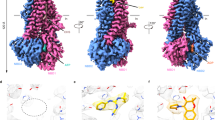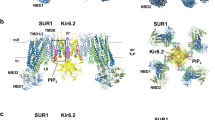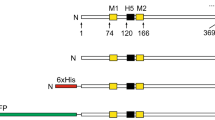Abstract
Aim:
ATP-sensitive potassium (KATP) channels formed by a combination of SUR/Kir6.x subunits play a crucial role in protection against hypoxic or ischemic injuries resulting from cell metabolic disorders. In this study we investigated the effects of Na-azide, a metabolic inhibitor, on KATP channels expressed in Xenopus oocytes, and explored the structure basis for their sensitivity to cell metabolic disorders.
Methods:
Six subtypes of KATP channels (wild SUR1/Kir6.2, SUR2B/Kir6.2, SUR1/Kir6.1, SUR2B/Kir6.1, SUR2A/Kir6.2 and SUR2A/Kir6.1), as well as eleven subtypes of KATP channels with mutant subunits were expressed in Xenopus oocytes. KATP currents were recorded using a two-electrode voltage clamp recording technique. The drugs were applied through bath.
Results:
Except SUR2A/Kir6.1, five subtypes of KATP channels were activated by Na-azide (3 mmol/L) with an order of the responses: SUR1/Kir6.2>SUR2B/Kir6.2>SUR1/Kir6.1>SUR2B/Kir6.1>SUR2A/Kir6.2, and the opening rate (t1/2) was SUR1/Kir6.x>SUR2B/Kir6.x>SUR2A/Kir6.2. Furthermore, Kir6.2, rather than Kir6.1, had intrinsic sensitivity to Na-azide, and the residues involved in ATP-binding (R50 and K185) or pH-sensing (H175) were associated with the sensitivity of the Kir6.2 subunit to Na-azide. Moreover, the residues (K707 and K1348) within the Walker A (WA) motifs of two nucleotide-binding domains (NBDs) were essential for SUR2B/Kir6.x (especially SUR2B/Kir6.1) channel activation by Na-azide, suggesting a key role for Mg-adenine nucleotide binding and/or hydrolysis in the SUR2B subunit.
Conclusion:
Among the six subtypes of KATP channels, SUR1/Kir6.2 is the most sensitive, whereas SUR2A/Kir6.1 is insensitive, to cell metabolic disorders. The Kir6.2 subunit, rather than the Kir6.1 subunit, has intrinsic sensitivity to cell metabolic disorders. The residues (K707 and K1348) within the WA motifs of SUR2B are important for the sensitivity of SUR2B/Kir6.x channels to cell metabolic disorders.
Similar content being viewed by others
Log in or create a free account to read this content
Gain free access to this article, as well as selected content from this journal and more on nature.com
or
References
Seino S, Miki T . Physiological and pathophysiological roles of ATP-sensitive K+ channels. Prog Biophys Mol Biol 2003; 81: 133–76.
Nichols CG . KATP channels as molecular sensors of cellular metabolism. Nature 2006; 440: 470–6.
Olson TM, Terzic A . Human KATP channelopathies: diseases of metabolic homeostasis. Pflugers Arch 2010; 460: 295–306.
Ballanyi K . Protective role of neuronal KATP channels in brain hypoxia. J Exp Biol 2004; 207: 3201–12.
Flagg TP, Enkvetchakul D, Koster JC, Nichols CG . Muscle KATP channels: recent insights to energy sensing and myoprotection. Physiol Rev 2010; 90: 799–829.
Hsu CY, Fang SY, Chen YZ, Roan JN, Chang SW, Huang CC, et al. Cardiovascular protection of activating KATP channel during ischemia-reperfusion acidosis. Shock 2012; 37: 653–8.
Barakat AI, Lieu DK, Gojova A . Ion channels in shear stress sensing in vascular endothelium. In: Bazopoulou D, Voglis G, Tavernarakis N, Benson CJ, Mccleskey EW, editors. Molecular sensors for cardiovascular homeostasis. Vienna: Springer-Verlag GmbH; 2007. Part III: 155–70.
Chatterjee S, Levitan I, Wei Z, Fisher AB . KATP channels are an important component of the shear-sensing mechanism in the pulmonary microvasculature. Microcirculation 2006; 13: 633–44.
Title LM, Lonn E, Charbonneau F, Fung M, Mather KJ . Relationship between brachial artery flow-mediated dilatation, hyperemic shear stress, and the metabolic syndrome. Vasc Med 2008; 13: 263–70.
Babenko AP, Aguilar-Bryan L, Bryan J . A view of SUR/KIR6.x KATP channels. Annu Rev Physiol 1998; 60: 667–87.
Hibino H, Inanobe A, Furutani K, Murakami S, Findlay I, Kurachi Y . Inwardly rectifying potassium channels: their structure, function, and physiological roles. Physiol Rev 2010; 90: 291–366.
Proks P, Ashcroft FM . Modeling KATP channel gating and its regulation. Prog Biophys Mol Biol 2009; 99: 7–19.
Kono Y, Horie M, Takano M, Otani H, Xie LH, Akao M, et al. The properties of the Kir6.1-6.2 tandem channel co-expressed with SUR2A. Pflugers Arch 2000; 440: 692–8.
Yamada M, Isomoto S, Matsumoto S, Kondo C, Shindo T, Horio Y, et al. Sulphonylurea receptor 2B and Kir6.1 form a sulphonylurea-sensitive but ATP-insensitive K+ channel. J Physiol 1997; 499: 715–20.
Li L, Wu J, Jiang C . Differential expression of Kir6.1 and SUR2B mRNAs in the vasculature of various tissues in rats. J Membr Biol 2003; 196: 61–9.
Shi W, Cui N, Wu Z, Yang Y, Zhang S, Gai H, et al. Lipopolysaccharides up-regulate Kir6.1/SUR2B channel expression and enhance vascular KATP channel activity via NF-kappaB-dependent signaling. J Biol Chem 2010; 285: 3021–9.
Zhou F, Yao HH, Wu JY, Ding JH, Sun T, Hu G . Opening of microglial KATP channels inhibits rotenone-induced neuroinflammation. J Cell Mol Med 2008; 12: 1559–70.
Thomzig A, Wenzel M, Karschin C, Eaton MJ, Skatchkov SN, Karschin A, et al. Kir6.1 is the principal pore-forming subunit of astrocyte but not neuronal plasma membrane KATP channels. Mol Cell Neurosci 2001; 18: 671–90.
Liu Y, Ren G, O'Rourke B, Marban E, Seharaseyon J . Pharmacological comparison of native mitochondrial KATP channels with molecularly defined surface KATP channels. Mol Pharmacol 2001; 59: 225–30.
Ng KE, Schwarzer S, Duchen MR, Tinker A . The intracellular localization and function of the ATP-sensitive K+ channel subunit Kir6.1. J Membr Biol 2010; 234: 137–47.
Gribble FM, Ashfield R, Ammala C, Ashcroft FM . Properties of cloned ATP-sensitive K+ currents expressed in Xenopus oocytes. J Physiol 1997; 498: 87–98.
Tammaro P, Proks P, Ashcroft FM . Functional effects of naturally occurring KCNJ11 mutations causing neonatal diabetes on cloned cardiac KATP channels. J Physiol 2006; 571: 3–14.
Dabrowski M, Larsen T, Ashcroft FM, Bondo Hansen J, Wahl P . Potent and selective activation of the pancreatic beta-cell type KATP channel by two novel diazoxide analogues. Diabetologia 2003; 46: 1375–82.
Zerangue N, Schwappach B, Jan YN, Jan LY . A new ER trafficking signal regulates the subunit stoichiometry of plasma membrane KATP channels. Neuron 1999; 22: 537–48.
Moreau C, Prost AL, Derand R, Vivaudou M . SUR, ABC proteins targeted by KATP channel openers. J Mol Cell Cardiol 2005; 38: 951–63.
Tucker SJ, Gribble FM, Zhao C, Trapp S, Ashcroft FM . Truncation of Kir6.2 produces ATP-sensitive K+ channels in the absence of the sulphonylurea receptor. Nature 1997; 387: 179–83.
Antcliff JF, Haider S, Proks P, Sansom MS, Ashcroft FM . Functional analysis of a structural model of the ATP-binding site of the KATP channel Kir6.2 subunit. EMBO J 2005; 24: 229–39.
Wang X, Wu J, Li L, Chen F, Wang R, Jiang C . Hypercapnic acidosis activates KATP channels in vascular smooth muscles. Circ Res 2003; 92: 1225–32.
Wu J, Cui N, Piao H, Wang Y, Xu H, Mao J, et al. Allosteric modulation of the mouse Kir6.2 channel by intracellular H+ and ATP. J Physiol 2002; 543: 495–504.
Matsuo M, Kimura Y, Ueda K . KATP channel interaction with adenine nucleotides. J Mol Cell Cardiol 2005; 38: 907–16.
Matsuo M, Tanabe K, Kioka N, Amachi T, Ueda K . Different binding properties and affinities for ATP and ADP among sulfonylurea receptor subtypes, SUR1, SUR2A, and SUR2B. J Biol Chem 2000; 275: 28757–63.
Yamada M, Kurachi Y . A functional role of the C-terminal 42 amino acids of SUR2A and SUR2B in the physiology and pharmacology of cardiovascular ATP-sensitive K+ channels. J Mol Cell Cardiol 2005; 39: 1–6.
Masia R, Enkvetchakul D, Nichols CG . Differential nucleotide regulation of KATP channels by SUR1 and SUR2A. J Mol Cell Cardiol 2005; 39: 491–501.
Farzaneh T, Tinker A . Differences in the mechanism of metabolic regulation of ATP-sensitive K+ channels containing Kir6.1 and Kir6.2 subunits. Cardiovasc Res 2008; 79: 621–31.
Gribble FM, Tucker SJ, Ashcroft FM . The essential role of the Walker A motifs of SUR1 in KATP channel activation by Mg-ADP and diazoxide. EMBO J 1997; 16: 1145–52.
Acknowledgements
We thank Prof LY JAN (Howard Hughes Medical Institute) for kindly providing cDNAs for the KATP channels used for expression in Xenopus oocytes.
This work was supported by grants from the State Key Research Project of China (No AWS11J003) and the National Basic Research “973” Program (No 2012CB518200 and JCKY2013000B001).
Author information
Authors and Affiliations
Corresponding author
Additional information
Supplementary Figure S1 is available in the Acta Pharmacologica Sinica's website.
Supplementary information
Supplementary Information, Figure S1
Representative time courses of currents recorded at -80 mV from water-injected Xenopus oocytes (B1), oocytes expressing SUR1/Kir6.1 (B2), SUR2A/Kir6.1 (B3), SUR2B/Kir6.1 (B4), SUR1/Kir6.2 (B5), SUR2A/Kir6.2 (B6) and SUR2B/Kir6.2 (B7). (DOC 24 kb)
Rights and permissions
About this article
Cite this article
Li, Cg., Cui, Wy. & Wang, H. Sensitivity of KATP channels to cellular metabolic disorders and the underlying structural basis. Acta Pharmacol Sin 37, 134–142 (2016). https://doi.org/10.1038/aps.2015.134
Received:
Accepted:
Published:
Issue date:
DOI: https://doi.org/10.1038/aps.2015.134
Keywords
This article is cited by
-
Ion channels research in the post-genomic era
Acta Pharmacologica Sinica (2016)



